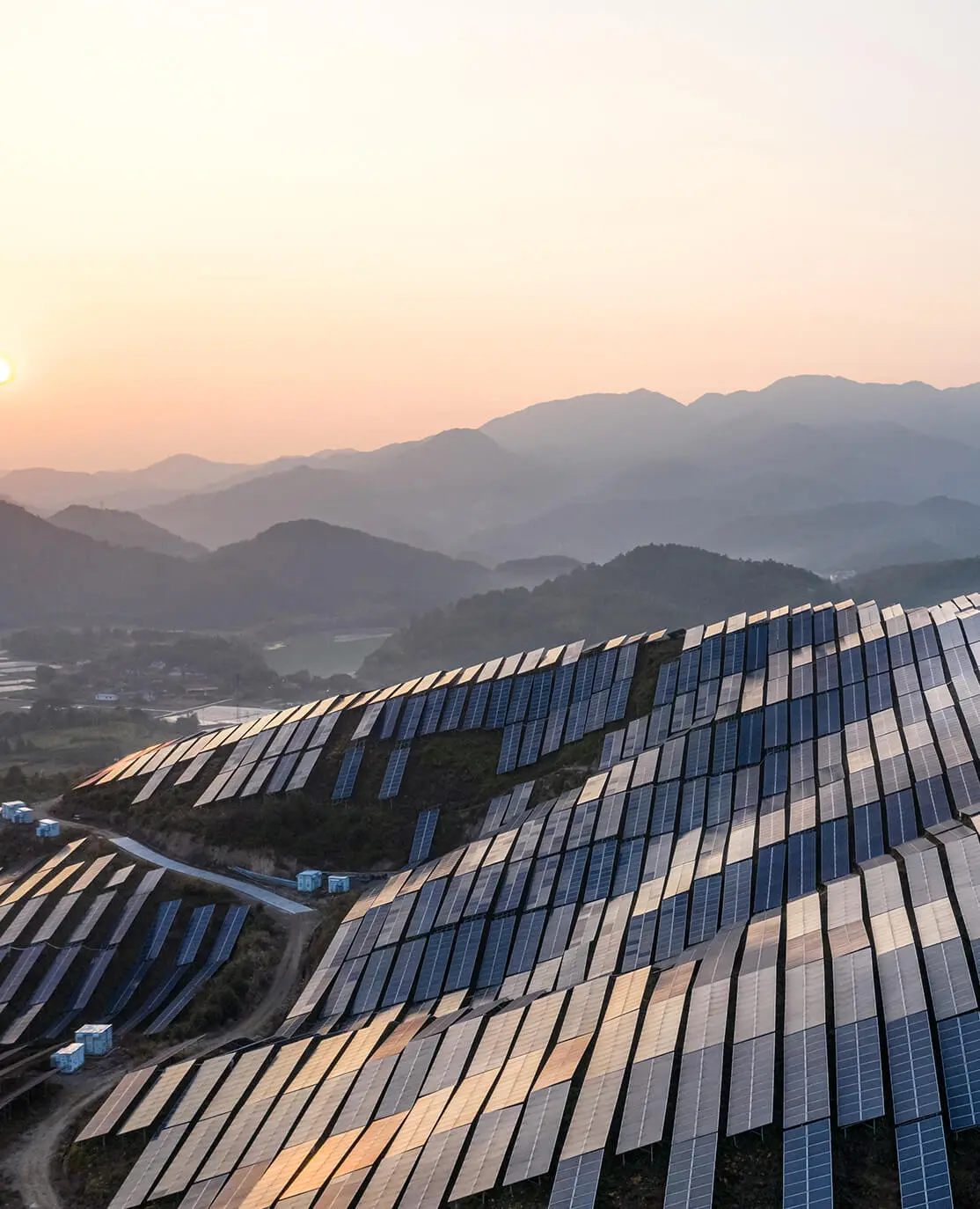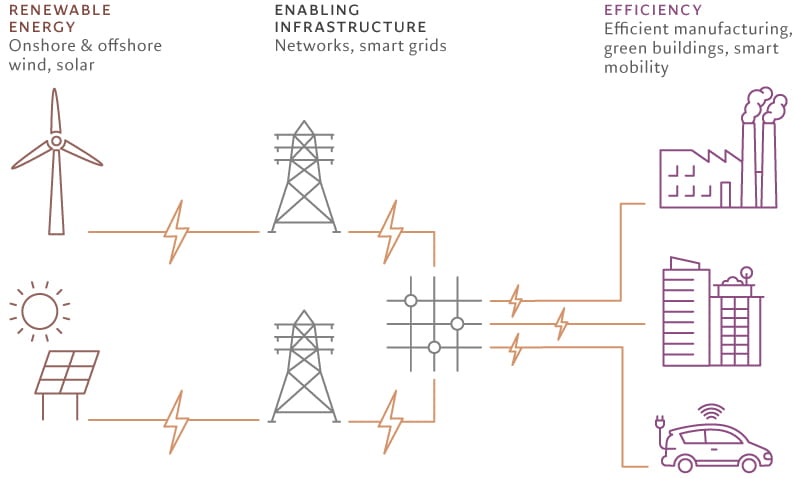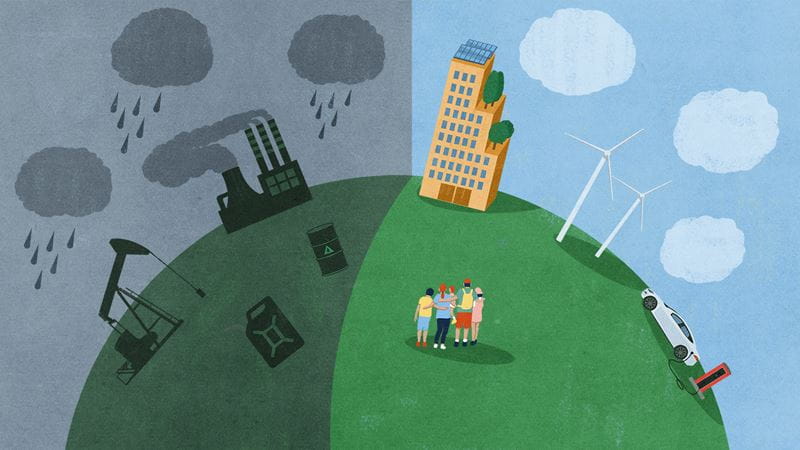The Clean Energy Transition: Opportunities Beyond The Obvious
The clean energy transition presents a huge investment opportunity, tapping into some of the fastest growing segments in the economy. One of the most obvious routes is investing in listed renewable energy companies.
The problem is that they are in increasingly short supply. According to our calculations, renewable energy stocks represent less than 8 per cent of the global equity market’s capitalization, or $9.3 trillion. That’s a relatively small and crowded pool.
Which means investors seeking green energy opportunities need to extend their reach within the energy transition ecosystem. It helps to take a broader view on what constitutes a clean energy investment. We believe this can be done through four broad themes, which cover the entire energy system value chain from supply to demand.

- Renewable energy: The costs of generating renewable energy have dropped steeply over the years and in many regions are now cheaper to deploy compared to fossil fuels. We believe that existing power utilities have a key part to play in this sector, given the improved economic attractiveness of renewables, and support from governments eager to meet their net-zero commitments.
- Energy efficiency: This is crucial for reducing the carbon footprint of energy-heavy industries such as transport, construction and manufacturing. Increased electrification (e.g. of vehicles) can help, although the impact is most significant if that electricity comes from renewable sources. By improving efficiency, the global economy can continue to expand without putting too much additional pressure on Earth’s resources.
- Enabling technologies: Battery storage and power-management semiconductors are just some of the technologies needed for the transition to a low carbon economy. Some are still being developed, but there is clear progress. For example, large-scale batteries are increasingly able to offer an effective and affordable way to smooth out the intermittency of renewable energy generation.
- Enabling infrastructure: Electric networks, smart grids and car-charging infrastructure are also necessary. For example, we need more transmission lines to transport renewable energy over long distances from areas with high wind/solar resources to the demand centers in cities.
Green Capex Boom
More broadly, we believe that investing in sustainable practices and technologies—so-called “Green Capex”—will be a multi-year secular theme driving the next wave of infrastructure investments across electrification, electricity grids, renewables, green buildings, battery storage, electric vehicles and more.
The current dislocations in the energy markets have been accentuated by the Russia-Ukraine conflict.
Investors seeking green energy opportunities need to extend their reach.
These will continue to stimulate corporate investments in energy-saving technologies, as well as providing an additional incentive for the transition away from fossil fuels. Not only is such a shift good for the environment and our planet, it is now also increasingly seen as a key step toward improved energy independence (particularly, but by no means exclusively, in Europe).
Ultimately, we believe that high-quality companies underpinned by secular growth will be more resilient than the broader economy and stand out because of the underlying structural drivers. By focusing on a broad universe of companies which have a part to play in the energy transition—rather than looking exclusively at the renewables sector—investors can achieve better diversification and access a wider pool of opportunities.
Key Pillars of the Clean Energy Revolution

Key Takeaways for the Clean Energy Transition
Takeaways for the Clean Energy Transition
- Increased sense of urgency globally to combat climate change and air pollution
- Clean energy becoming more competitive as technology innovation enables steep cost reductions
- Supported by governments aiming to improve energy security and independence
Driving transformations in entire industries
- Redirecting entire energy production landscape toward renewables
- Transformation of the transport industry toward electrified and smart mobility
- Focus on energy efficiency driving new solutions in infrastructure and manufacturing
Creates opportunities in some of the fastest growing economic sectors
- A diverse opportunity set allows for investment optionality
- High-quality companies with strong free cash flows and high barriers to entry
- Secular theme provides long-term visibility on growth



Important legal information
This marketing material is issued by Pictet Asset Management (Europe) S.A.. It is neither directed to, nor intended for distribution or use by, any person or entity who is a citizen or resident of, or domiciled or located in, any locality, state, country or jurisdiction where such distribution, publication, availability or use would be contrary to law or regulation. The latest version of the fund‘s prospectus, Pre-Contractual Template (PCT) when applicable, Key Information Document (KID), annual and semi-annual reports must be read before investing. They are available free of charge in English on www.assetmanagement.pictet or in paper copy at Pictet Asset Management (Europe) S.A., 6B, rue du Fort Niedergruenewald, L-2226 Luxembourg, or at the office of the fund local agent, distributor or centralizing agent if any.
The KID is also available in the local language of each country where the compartment is registered. The prospectus, the PCT when applicable, and the annual and semi-annual reports may also be available in other languages, please refer to the website for other available languages. Only the latest version of these documents may be relied upon as the basis for investment decisions.
The summary of investor rights (in English and in the different languages of our website) is available here and at www.assetmanagement.pictet under the heading "Resources", at the bottom of the page.
The list of countries where the fund is registered can be obtained at all times from Pictet Asset Management (Europe) S.A., which may decide to terminate the arrangements made for the marketing of the fund or compartments of the fund in any given country.
The information and data presented in this document are not to be considered as an offer or solicitation to buy, sell or subscribe to any securities or financial instruments or services.
Information, opinions and estimates contained in this document reflect a judgment at the original date of publication and are subject to change without notice. The management company has not taken any steps to ensure that the securities referred to in this document are suitable for any particular investor and this document is not to be relied upon in substitution for the exercise of independent judgment. Tax treatment depends on the individual circumstances of each investor and may be subject to change in the future. Before making any investment decision, investors are recommended to ascertain if this investment is suitable for them in light of their financial knowledge and experience, investment goals and financial situation, or to obtain specific advice from an industry professional.
The value and income of any of the securities or financial instruments mentioned in this document may fall as well as rise and, as a consequence, investors may receive back less than originally invested.
The investment guidelines are internal guidelines which are subject to change at any time and without any notice within the limits of the fund's prospectus. The mentioned financial instruments are provided for illustrative purposes only and shall not be considered as a direct offering, investment recommendation or investment advice. Reference to a specific security is not a recommendation to buy or sell that security. Effective allocations are subject to change and may have changed since the date of the marketing material.
Past performance is not a guarantee or a reliable indicator of future performance. Performance data does not include the commissions and fees charged at the time of subscribing for or redeeming shares.
Any index data referenced herein remains the property of the Data Vendor. Data Vendor Disclaimers are available on assetmanagement.pictet in the “Resources” section of the footer. This document is a marketing communication issued by Pictet Asset Management and is not in scope for any MiFID II/MiFIR requirements specifically related to investment research. This material does not contain sufficient information to support an investment decision and it should not be relied upon by you in evaluating the merits of investing in any products or services offered or distributed by Pictet Asset Management.
Pictet AM has not acquired any rights or license to reproduce the trademarks, logos or images set out in this document except that it holds the rights to use any entity of the Pictet group trademarks. For illustrative purposes only.

